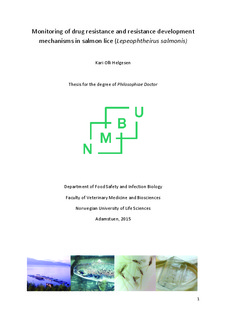| dc.contributor.advisor | Horsberg, Tor Einar | |
| dc.contributor.advisor | Kaur, Kiranpreet | |
| dc.contributor.advisor | Sørum, Henning | |
| dc.contributor.author | Helgesen, Kari Olli | |
| dc.date.accessioned | 2017-07-13T12:48:31Z | |
| dc.date.available | 2017-07-13T12:48:31Z | |
| dc.date.issued | 2017-07-13 | |
| dc.identifier.isbn | 978-82-575-1957-5 | |
| dc.identifier.issn | 1894-6402 | |
| dc.identifier.uri | http://hdl.handle.net/11250/2448691 | |
| dc.description.abstract | The parasite salmon louse (Lepeophtheirus salmonis) poses a threat to the salmonid aquaculture in the Northern Hemisphere. Depending on the developmental stage and the abundance of lice, these parasites can cause stress, skin erosions, wounds, anaemia and osmoregulatory difficulties in the fish. A large infestation may even be fatal to their hosts. The direct effects of the lice can create gateways for secondary infections. Furthermore the parasites may also act as passive vectors for other disease agents. Due to their huge reproductive capacity and the presence of planktonic life stages, the salmon lice from one fish farm can infest other fish at the same farm, in neighbouring farms as well as wild salmonids. To reduce the infestation pressure on wild salmonids and the potential harmful effects on the farmed fish, it is necessary to constantly maintain a low level of salmon lice on the fish. This has predominantly been achieved by the use of chemical treatments.
Due to both frequently applied treatments and dependence on a limited number of chemical treatment agents, salmon lice have developed resistance towards the most commonly used chemotherapeutants. When a chemical treatment fails, it is necessary to determine if the failure was due to resistant salmon lice or an erroneously performed treatment. This is achieved through the use of resistance tests which are also useful in determining the pre-treatment sensitivity level of the salmon lice. This information helps avoid carrying out unsuccessful treatments, which are expensive for the fish farmer as well as stressful and potentially harmful for the fish and the marine environment. The biological assays (bioassays), which are traditionally applied as resistance tests, require many parasites, delicate handling of the lice and are performed using various protocols. The aim of the current thesis was to refine existing methods and develop new techniques for the monitoring of drug resistance in salmon lice. | nb_NO |
| dc.description.abstract | Lakselus (Lepeophtheirus salmonis) er en parasitt som utgjør en stor trussel mot oppdrett av laksefisk på hele den nordlige halvkule. Infeksjoner med lakselus stresser fisken. I tillegg kan lusene forårsake huderosjoner, sår og anemi, og gi fisken problemer med osmoreguleringen. En kraftig infeksjon kan være dødelig for fisken. De direkte effektene av lus kan skape inngangsporter for sekundærinfeksjoner. Lus kan også fungere som mekaniske vektorer for andre sykdomsagens. På grunn av den store reproduksjonskapasiteten til lus, samt at flere av livsstadiene er planktoniske, utgjør lus fra ett anlegg en smitterisiko for andre fisk på samme anlegg, for fisk på naboanlegg og for vill laksefisk. For å begrense smittefaren til villfisk og for å redusere risikoen for sykdom på fisk i eget anlegg, må oppdrettere holde lusenivået nede. Kjemisk avlusing av fisk har vært den absolutt vanligste måten for å holde kontroll på lusetallet.
Tilgang til få ulike kjemiske avlusningsmidler samt hyppige behandlinger har ført til at lakselus har utviklet resistens mot behandlingsmidlene. Dersom resultatet fra en behandling ikke blir som forventet er det nødvendig å ha resistenstester, slik at en kan finne ut om behandlingssvikten var forårsaket av resistente lus eller av feilaktig utført behandling. I tillegg er det nyttig å utføre resistenstester før behandling, slik at en unngår mislykkede behandlinger. Kjemisk avlusning er kostbart for oppdretteren og stressende og potensielt skadelig for fisken og miljøet. De tradisjonelle resistenstestene krever mange lus, en skånsom håndtering av lusene, og blir utført etter flere ulike protokoller. Målet med denne avhandlingen var å forbedre og forenkle de allerede eksisterende resistenstestene samt å utvikle nye teknikker for å resistensteste lus. | nb_NO |
| dc.language.iso | eng | nb_NO |
| dc.publisher | Norwegian University of Life Sciences, Ås | |
| dc.relation.ispartofseries | PhD Thesis;2015:44 | |
| dc.title | Monitoring of drug resistance and resistance development mechanisms in salmon lice (Lepeophtheirus salmonis) | nb_NO |
| dc.type | Doctoral thesis | nb_NO |
| dc.source.pagenumber | 1 b. (flere pag.) | nb_NO |
| dc.relation.project | Norges forskningsråd: 199778/S40 og 203513/030 | nb_NO |
